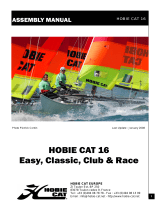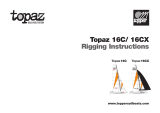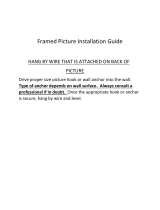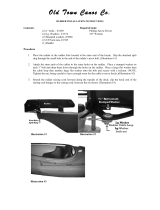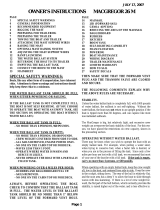Page is loading ...

1
Hobie Cat®
Owner’s manual - Hobie T2

2
Hobie Cat®
Owner’s manual - Hobie T2
Congratulations for the purchase of your new HOBIE CAT and welcome to the HOBIE sailing family. The Hobie Cat is a long life boat.
We offer this manual as a guide to increased safety and enjoyment of your new boat. The purpose of this publication is to provide easy,
simple and accurate instructions on how to get your Hobie ready for the water. Please read them carefully and familiarize yourself with
the boat and all of the parts spread before you.
Whether you are a new sailor or a veteran of many years, we recommend that you read this thoroughly before your first sail and TRY IT
OUR WAY FIRST! If you are new to sailing, this manual alone is not intended to teach you how to sail. There are many excellent books,
videos and courses on the safe handling of small sailboats. We suggest that you contact your local sailboat dealer, college or Coast
Guard Auxiliary for recommendations.
Watch for overhead wires whenever you are rigging, launching, sailing or trailering with the mast up. CONTACT OF THE MAST WITH
POWER LINES COULD BE FATAL! Be certain that the rigging area and the area that you will be sailing in are free of overhead power
lines. Report any such power lines to your local power authority and sail elsewhere.
We take pride in presenting this Hobie T2 to you and hope that you’ll take as much pride in owning her.
Fair winds and good sailing!
Hobie Cat Family.
Welcome in the «Hobie Way of Life»

3
Hobie Cat®
Owner’s manual - Hobie T2
Table of Contents
Owners Manual
Boat Description ................................................................................................................................................................................................4
Safety Advices ....................................................................................................................................................................................................5
Complementary Information .............................................................................................................................................................................6
Handling & Maintenance ...................................................................................................................................................................................7
Assembly Manual
Parts List ............................................................................................................................................................................................................ 9
Hull Assembly : Crossbar Fixation ..................................................................................................................................................................11
Trampoline Assembly ......................................................................................................................................................................................13
Front Spreader Bar .......................................................................................................................................................................................... 16
Wire Assembly .................................................................................................................................................................................................17
Mast Set-up : Wire Assembly ..........................................................................................................................................................................18
Stepping the Mast ............................................................................................................................................................................................21
Trapeze Assembly ............................................................................................................................................................................................ 23
Main Sail ..........................................................................................................................................................................................................24
Cunningham .....................................................................................................................................................................................................25
Mainsheet System............................................................................................................................................................................................26
Easy Lock Rudder Assembly ...........................................................................................................................................................................28
Tiller Crossbar and Extension .........................................................................................................................................................................29
Righting Line and Mast Floating Device .......................................................................................................................................................... 30
Spinnaker Kit (Option) ......................................................................................................................................................................................31

4
Hobie Cat®
Owner’s manual - Hobie T2
Length 16’ / 4.90 m
Beam 7’ 8” / 2.34 m
Draft w/ Rudder Up 10” / 0.25 m
Mast Length 26’ 6” / 8.07 m
Weight 388 lbs / 176 kg
Sail Area 172 ft
2
/ 16 m
2
Capacity 388 lbs / 176 kg
Crew 1-4
Hull construction Rotomolded
Polyethylene
Boat Description

5
Hobie Cat®
Owner’s manual - Hobie T2
Read carefully before sailing :
• Whether on land or on the water, WATCH FOR OVERHEAD POWER LINES. Contact with power lines can cause serious injury or
death.
• DO NOT sail while under the influence of alcohol and/or drugs
• Only sail in conditions in which you feel comfortable and where you feel confident that you can safely sail the boat. Never go out in
conditions beyond your ability.
• Everyone on board should wear a life jacket at all times (see the regulations in force).
• If you are in the water, remain in contact with the boat, even if it is capsized. A sailboat can drift away faster than a person can swim.
• Never sail without a righting line.
• Wear appropriate clothes. Wear a wet suit or dry suit in cold weather or cold water conditions.
Protect yourself against heat and sun.
• Learn about the local sea regulations.
• Learn the right of way rules and when in doubt, give way to others.
• When not sailing, always keep the boat pointed into the wind whether in the water or on the beach.
• Read the instruction manual carefully.
• Make sure everyone on the boat reads and understands these safety instructions.
• ALWAYS check that the drain plugs are screwed in before launching your catamaran. Remove the plugs after sailing to drain any
water that may have leaked into the hulls.
Safety equipment :
All necessary safety equipment must be available on board. (Life jackets, etc.) and must correspond to the boat type, weather
conditions, etc. This material is mandatory in some countries. The crew must know how to use this material and how to behave in case
of emergency (men at sea, towing, etc.); Sailing schools and clubs regularly organize training sessions to learn how to use the safety
equipment and how to behave in case of emergency.
Safety Advices

6
Hobie Cat®
Owner’s manual - Hobie T2
INTERNATIONAL HOBIE CLASS ASSOCIATION (I.H.C.A.)
Hobie Cat owners are organized in a world-wide class association : the IHCA (International Hobie Class Association).
Visit their web site : http://www.hobieclass.com/ to find the name and contact details of the association of your country.
Complementary Information

7
Hobie Cat®
Owner’s manual - Hobie T2
Before sailing, check the following points :
1/ Install the drain plugs (if any) – do not overtighten, hand tight is sufficient. Overtightening may
cause the drain plug flange to distort and cause leakage.
2/ Tension the rig. This can be accomplished by having your assistant hang from the trapeze or you
can use mainsheet tension on one side at a time so that you can adjust the shroud position in the
side stay adjusters.
3/ Check all fastenings :
• Mast tang shackles and shrouds (to prevent the mast from falling down)
• pins and trapeze rope locks (to prevent falling out in the water if the trapeze is not well fastened)
• pins and spring rings on the forestay and shrouds (to prevent the mast from falling down)
• spring rings on the rudder pins (to prevent loosing the rudder assembly in case of capsizing)
Transport
In order to avoid hull damages :
• Always use a dolley to transport your Hobie on the beach (even if it is a sand beach) and for launching. Step into the water with the
dolley and once the cat is afloat take out the dolley.
• DO NOT BEACH. Beaching, even smoothly, may damage the hulls. use your beach dolley to take the boat out of the water.
• For towing, always use a road trailer with cradles.
Launching your Hobie Cat
Launching the boat is easiest when the boat can be pointed into the wind to keep it de-powered and floated into deep enough water to
lower the rudders.
It is possible to launch in shallow water with the rudders partly up.
Try not to steer with too much force on the rudders until you lock them in the down position.
Keep the sail loose and trimmed out completely until you can power up and steer away from any obstacle.
Handling & Maintenance

8
Hobie Cat®
Owner’s manual - Hobie T2
Righting your Hobie Cat
If you tip the boat over, in order to avoid the mast from sinking under the hull, one of the crew must
rapidly climb on the hull that remains on the water. In the meantime, the other crew uncleat all
the lines and sheets.
It is not necessary, but it is easier to right the boat when the bow and the mast are pointed into the
wind. There will be less resistance and better control in this position.
Skipper and crew stand up on the hull. Using the righting line, skipper and crew pull the righting
line that is against the upper hull and hold the line while slowly leaning back away from the
trampoline. As the mast and sail lift out of the water, drop down to your knees then into the water.
Hold on to the crossbar near the hull that you were standing on.
Be well aware of the hull and crossbar coming down over your head. Holding the crossbar or
righting line will also insure that you remain with the boat when it is righted. Climb aboard and continue sailing.
Maintenance of your Hobie
• Hobie Cat does not recommend leaving your Hobie in the water on a mooring. Accelerated wear to the boat and rigging will be
experienced. Damage to the hull material is possible. Limitation of the mast rotation and tensioning of the rigging are required to
lessen this wear. Inspect rigging often and tape rigging rings and shackles to prevent loosening.
• After sailing, it is recommended to wash the hulls to remove any salt. Also remove the sails and wash them. Only store them when
they are perfectly dry.
• There is one plug in the rear of each hull. These plugs are used to drain the hulls. The plugs should be in place before sailing.
Remove the plugs after sailing to drain any water that may have leaked into the hulls. It is best to travel with and store the boat with
the plugs removed to allow for pressure changes due to heating, cooling, and altitude changes. This will prevent warping of the hull
surface.
Handling and Maintenance

9
Hobie Cat®
Owner’s manual - Hobie T2
Your Hobie T2 is composed of :
Description
2 Hulls (right & left)
2 Crossbars (front & rear)
1 Trampoline
1 Mast
2 Rudder assembly (right & left)
1 Tiller crossbar
1 Wire bag with furler
1 Rig bag
1 Rope bag
1 Aluminum tiller extension
1 Colored main sail
1 Main batten set
1 Jib
Optional material:
1 Spinnaker pole (same for gennaker)
1 Spi rig bag
1 Spinnaker sail
1 Spi Trumpet
1 Spi bag
1 Gennaker sail
1 gennaker rig bag
Parts List

10
Hobie Cat®
Owner’s manual - Hobie T2
List of the parts : Wire bag with jib furler
1 Shrouds, Trap Wires
2 Rope Kit
3 Mainsheet Blocks
4 Furler & Bridles
5 Trapeze Handles
6 Rigging Hardware Kit
7 Beam Bolts
1
3
4
5
6
7
2

11
Hobie Cat®
Owner’s manual - Hobie T2
Hull Assembly : Crossbar Fixation
Illustration Steps Description
For the assembly we will use the #17 wrench and the crossbar screws that are included in the rig bag.
DO NOT USE any ratchet key on the screw.This would cause over heating of the screw in the insert.
1
Position the hulls in parallel with the inner sides facing
the ground. Lift the right hull. One person straddles
the hull to hold it in place. The other person applies
the silicone sealant (against corrosion of the screws)
around the holes.
2
Lift the left hull. Position the front crossbar on the
hull supports. (the trampoline tracks of the two hulls
should face one to the other inside the frame).
3
Insert the screws and washers as indicated in the
photo: aluminium washer first, then nylon washer.

12
Hobie Cat®
Owner’s manual - Hobie T2
Hull Assembly : Crossbar Fixation
Illustration Steps Description
4
Drive the screws into the front crossbar, on the left side
and then on the right side so that the crossbar is rightly
positionned (tighten loosely).
5
Rear crossbar: Apply silicone sealant around the screw
holes. Position the bar accross the hulls and insert the
screws, washers and nuts in the same way as for the
front crossbar.
Caution! the trampoline lacing post must face towards
the rear of the boat.
Lastly, fully tighten the 4 bolts of the front crossbar and the 4 bolts of the rear crossbar.
Regularly check the fastening of the crossbar nuts and the dolphin striker rod.

13
Hobie Cat®
Owner’s manual - Hobie T2
Trampoline Assembly
Illustration Steps Description
1
The opening to slide the two parts of the trampoline
is on the left side of the front crossbar, so insert first
the right half of the trampoline and afterwards the left
part.
2
Then slide the lateral edge of the left trampoline into
the track of the left hull. Repeat the same thing on
the right side : insert the lateral edge of the right
trampoline into the track of the right hull.
3
Middle Lacing
Tie a bowline knot on the first eyelet on the left side of
the trampoline. Begin the lacing.

14
Hobie Cat®
Owner’s manual - Hobie T2
Trampoline Assembly
Illustration Steps Description
4
Continue lacing until the very last eyelet and stop knot
at the end just in front of the rear crossbar.
5
Insert the fiberglass trampoline rod into the rear
stripes of the two trampolines halves.
6
Commence lacing the rear of the trampoline. The
lacing line starts at the first eyelet on the rear left
corner. The lacing line goes up around the 1st post,
then around the 2nd post, then down around the rod,
then up once again around the 2nd post, then around
the 3rd post. Continue in the same way until the last
post and tighten firmly at each step.

15
Hobie Cat®
Owner’s manual - Hobie T2
Illustration Steps Description
7
When the lacing comes to the end, make a loop and use
it to tension and tighten the lacing line using half-key
knots to secure it.
The trampoline must always be fully tightened.
Check the tension on a regular basis and each time you get on the water.
Trampoline Assembly

16
Hobie Cat®
Owner’s manual - Hobie T2
Front Spreader Bar
Illustration Steps Description
1
Install bow spreader bar with the two anchor bolts
provided in the rigging kit.
2
Attach the jib bridles using the clevis pin and split rings
supplied.
NEVER USE THE FORWARD SPREADER BAR TO CARRY THE BOAT.
Use the 4 handles to carry the boat (2 holes at the front, 2 molded-in at the rear of the boat).

17
Hobie Cat®
Owner’s manual - Hobie T2
Wire Assembly
Illustration Steps Description
1
Shroud anchor plates
Take the two shroud anchor plates and fix them on the
hull with the screws.
2
Fixing the stay adjusters
Take the stay adjusters and fix them to the anchor
plates using the axes and split rings. Then attach the
shrouds on the top of them.

18
Hobie Cat®
Owner’s manual - Hobie T2
Illustration Steps Description
1
Take the main halyard rope in the rope bag.
Attach the main halyard rope to the main halyard wire
(falling from the mast head) with a bowline knot. Set
the halyard wire and rope alongside the mast and
secure them at the bottom of the mast around the
halyard cleat.
2
Fixing the wires to the mast
Take in the rig bag the 8 mm shackle and attach the
wires to it as shown on the drawing.
1. trapeze wires for the skipper (on the pin)
2. trapeze wires for the crew
3. shroud wires
4. rear jib luff pigtail
5. Jib halyard rope
Attach the shackle with the wires on the mast tang.
Mast Set-up : Wire Assembly
T2 mast extrusion to CompTip assembly: The purpose is to bond the two sections together and seal out water. This will keep the joint in
proper alignment. This can affect the sail shape if the fit becomes loose. Use masking tape to mask the area above and below the joint
to make cleanup easier. Also block off the luff track. Be prepared to use some force during the insertion. Place the base of the mast
against a solid but padded object. Apply the bonding agent to the inside and outside of the mating sections. Fit the two parts together as
far as possible. Prop the mast up so that the track is straight up, then sight down the length with your eye to check the alignment at the
joint. Straighten if necessary. Remove masking tape before the glue dries. Allow bonding agent to completely dry before moving mast.

19
Hobie Cat®
Owner’s manual - Hobie T2
Illustration Steps Description
If you do not have the jib furler, go directly to the next page
7
Take the jib furler in the wire bag and connect it to the
two bridle wires using the clevis pins and split rings.
Caution! Ensure that the exit hole in the furler is
pointing at the furler cleat on the front crossbar. Check
that the screw on the underside of the furler is tight.
This prevents the outer cover from rotating.
8
Wind the furler up in a clockwise direction. Leave
enough furler line to reach the furler cleat on the front
crossbar.
Mast Set-up : Wire Assembly (model with jib furler)

20
Hobie Cat®
Owner’s manual - Hobie T2
Illustration Steps Description
With the base of the mast facing towards the front of the boat, lay the mast on top of the boat. (place some padding un-
der the mast to prevent scratching). Put the wires on each side of the boat.
9
Connect the shrouds to the stay adjuster on the hull, using
the clevis pins and the split rings.
At this stage, attach them in the upper hole. The position
may be changed afterwards.
The position in the stay adjuster determines the mast rake.
You can pull the cover partially over the stay adjusters at
this time. The assembly of the trapeze wires can wait until
after you have raised the mast.
Spinnaker Option:
Insert the spi halyard into the small block at the top of the mast (see the drawing for the mounting of the spinnaker at
the end of this manual).
CAUTION DANGER : ALUMINIUM MAST
STAY AWAY FROM ELECTRICAL WIRES
CONTACT WITH ELECTRICAL WIRES MAY CAUSE DEATH
Mast Set-up : Wire Assembly
/

